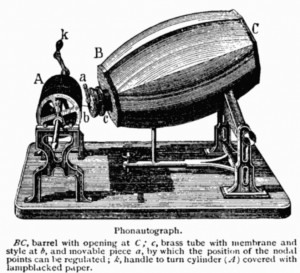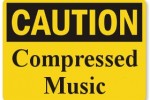It was once thought that the earliest recording of the human voice was made by Thomas Edison in 1877, when he recorded Mary had a Little Lamb on his new invention – the phonograph.
BUT, a new recording has turned up. It was made on April 9, 1860 and it is of a woman singing the French folk song “Claire de la lune”. It has now been heard for the first time in 150 years.
You can hear the recording here in mp3 format. Don’t expect Dark side of the Moon production here – remember, we’re talking first recordings ever made.
The interesting thing is that the recording was never intended to be played back – or at least the technology to play it back was never imagined at the time.
It was recorded by a “phonautograph”, which etches waveforms onto paper. French inventor Edouard-Leon Scott de Martinville built the device, which uses a diaphragm that responds to sound to etch the lines onto paper via the soot from an oil lamp.
 Scientists have managed to play back the recording using a virtual “stylus”, which is really a computer program that reads the recording from a scanned image. The process sort of reminds me of this extremely interesting technique.
Scientists have managed to play back the recording using a virtual “stylus”, which is really a computer program that reads the recording from a scanned image. The process sort of reminds me of this extremely interesting technique.

A group of audio historians called “First Sounds ” have been working as archiving early recordings and worked with Paresian Mr. Giovanni, who retreived the sounds from the paper at the Lawrence Berkeley National Laboratory (LBNL) in California.
As the phonautograph was a manually-cranked device (no, they didn’t have crystal timing then!), the speed varied throughout the recording and likewise the pitch changes somewhat over time, giving it a bit of a warbly sound.
The oldest sound ever recorded (also on the phonautograph) is here. It’s one of the early “beta tests” of the unit, and yielded a garbled mess.
 The oldest recognizable sound ever recorded was that of a tuning fork at 435Hz on the phonautograph. Presented here in various stages of restoration.
The oldest recognizable sound ever recorded was that of a tuning fork at 435Hz on the phonautograph. Presented here in various stages of restoration.
If you’re into vintage recordings and the history of it all, this is an amazing DVD – definitely check it out.






It’s actually a man singing, not a women. It’s just being played at the wrong speed
Hear me out here…no pun intended…
If beings are able to provide waves of sound that aren’t able to be played back at the time they’re produced, could it stand to reason that there are types of communication (I’m thinking recently of the “singing comet” and other types of alien bio-music) for which we have yet to develop the technology to decipher?
Researching a lot and just looking for any outlet I can find to prompt a discussion. Cool site, I appreciate it.
Hi, it Lana, you might be able to answer these question, Do you know where the oldest song was made? and How was it recorded because it wasn’t a laptop or anything because laptops and iPad’s were not invented. Just try and answer them if you cant thank you anyway. Talk soon.
Waaooh! IT IS VERY AMAZING .
The record proves the geniusness of the inventor of such a recording device.
Though he didn’t intend to record the voice for the later listening,
the man paved a way for sound preservative technology we have.
¤BRAVO¤
That recording of Au Claire De Lune was very garbled. I wonder if someone could remaster it, like reviving an old photograph with photoshop.
Love this.. I could be wrong but I think his last name is ‘Scott’ as Martinville is the town he is from..
I was just thinking, too bad someone did not try to record Lincoln’s voice because he was still alive when this recording of the woman singing was made. drat as Sheldon would say.
if i recall, martinville was using the production of the wavy, spiral line to show his students a way to look at the nature of sound–maybe i should say, a part of sound’s nature. If you had tried to talk to those guys, suggesting that, in the future (less than 20 years hence), you would be able to record and hear the sound, itself, they would have given you a wonderous stare. Maybe i shouldn’t say “the sound itself”! In any case, when EDison came forth with the other half of the answer, for OUR purpose, Martinville felt cheated, I think i read.
That is interesting. I’m wondering what Martinville’s invention was supposed to be used for.
That is absolutely haunting. Is it possible to restore the recording, like the way an old photograph can be restored in Photoshop?
The only thing : it is “Au clair de la lune”, not only “Claire de la lune”. Great infos!
This is amazingly cool. I was just having breakfast with my friend and we were talking about phonographs. We looked this up and were astonished.
Great piece.
JG
Fascinating! Thanks so much!